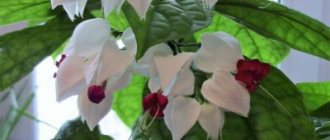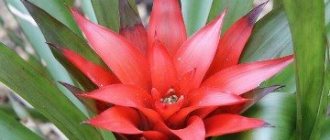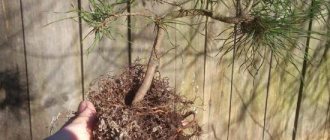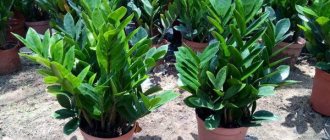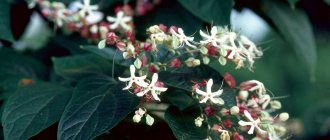Botanical description
In a natural environment, the vine grows up to 4 meters in length, in domestic environments - up to two. The plant has a long flowering period, up to 6 months, starting from March - April and ending in September - October.
Characteristics of Clerodendrum Thompson:
| Stem | Climbing, woody vine |
| Leaf Shape | Oval, grooved along the veins, up to 12 cm in length |
| Leaf color | Greens |
| Flower shape | Bracts - in the form of inverted cups or bells with a diameter of up to 3 cm. Flowers - in the form of a five-lobed corolla with stamens |
| Flower color | The bracts are white, turning pink and lilac over time; flowers are bright red, becoming dark cherry over time |
| Fruit shape | Oval, length about 1 cm |
| Fruit color | Orange |
Conditions for growing at home
Growing at home requires observing temperature and humidity conditions, as well as the correct location.
Location
In its natural habitat, Thompson's clerodendrum grows under the canopy of trees, so it needs the right ratio of light and shade. The most suitable location is on the windowsills of east and west windows. If the windows are on the south side, then the pot with the vine is placed deep into the room to provide shade, which will help avoid direct sunlight. If the windows are on the north side, it is recommended to use additional lighting during the growing season and flowering period (from mid-spring to mid-autumn).
Did you know? This type of clerodendrum was named after the Scottish missionary George Thompson. Thanks to him, the flower came to European countries.
Temperature
During the warm period, the optimal temperature for clerodendrum is +19…+25 °C; if this range is exceeded, it is recommended to correct it using an air conditioner.
After flowering, a dormant period begins (late autumn - late winter), during which it sheds its leaves. A plant without leaves must be kept in a room with a temperature of +12...+15 °C, otherwise next year it may produce very poor flowering or not bloom at all.
Air humidity
Clerodendrum Thompson requires high humidity. To maintain moisture, the vine is often sprayed with a spray bottle. It is especially important to carry out this procedure on hot summer days and when heating appliances are operating, as they dry the air. After the clerodendrum has dropped its leaves, spraying should be stopped.
Important! During the heating period, it is forbidden to place clerodendrum near a radiator or other heating devices to avoid dry air, which can lead to illness.
Home care
Thompson's clerodendrum is quite demanding in care, so it is important to know exactly how to care for it.
Watering
The plant needs regular moisture. Watering is increased during the growth and flowering periods. It is important to maintain a stable level of soil moisture without overdrying or flooding it. Complete drying of the soil leads to wilting and falling of the leaves, and dampness leads to rotting of the root system. You can understand that it’s time to water the plant if the top layer of soil (about 2–3 cm) has dried out a little. In the summer, watering is usually carried out 1-2 times a week; by autumn the amount is gradually reduced. During the cold period, the vine absorbs water less well, so it needs to be watered less abundantly.
Important! It is necessary that the water for irrigation settles for at least 3 days.
For irrigation, it is recommended to use settled water heated to room temperature.
Top dressing
Clerodendrum is fed from the beginning of March to the end of November, until the dormant period begins. You can feed it with fertilizer for beautifully flowering indoor plants in liquid form. To improve flowering, you can use fertilizers that contain potassium and phosphorus. It is advisable to use preparations that contain nitrogen exclusively at the beginning of the growing season. In spring and summer, the plant is fertilized once a week, in the fall - once a month, and in winter, fertilizing is stopped altogether.
Trimming
It is necessary to prune Thompson's clerodendrum in early spring (when foliage appears, before active growth begins). This must be done annually. Pruning not only improves the appearance of the vine, but also helps shape its crown. Thanks to this, Thompson's clerodendrum can be shaped as a shrub, standard tree, etc. When pruning shoots, approximately one-third of the length is cut off, thereby stimulating the growth of lateral branches.
Transfer
One of the important aspects of care is transplantation. Young plants are replanted every year, older plants - once every 2-3 years. Transplantation is carried out in the spring, before active growth begins, but after pruning.
We recommend reading about caring for clerodendrum philippines at home.
You can buy soil for replanting, but be sure to add peat, sand, humus and coniferous soil (in equal parts). You can also take rose primer and azalea primer and mix them in a 4:1 ratio. Before planting, the soil must be disinfected.
You need to take a pot with a diameter approximately 2 cm larger than the previous one.
To carry out a transplant you need:
- Place expanded clay-based drainage in the pot in a layer 2 to 4 cm high.
- Carefully transfer the clerodendrum from one pot to another.
- Fill empty spaces with new substrate.
- Water the sprouts.
- Carefully observe the vine for 5 days to understand whether it has managed to adapt to the new conditions.
Video: transplanting and pruning clerodendrum thompson
Magical properties of the plant
Despite its exotic origin, Thompson clerodendrum has been grown for a long time in different parts of the world as a greenhouse and indoor plant. In ancient Rome, an unusual vine was called the tree of fate. It was considered a symbol of love and was dedicated to the goddess Venus herself.
People believed that growing the Thompson plant brought happiness and good fortune. Of particular value is the flowering vine, reaching several meters in length. Flowering of the Thompson variety occurs in several stages:
- snow-white sepals;
- scarlet petals;
- stamens;
- light lilac color.
Attention! The flowering stage is long. However, the appearance of flowers can only be expected if the necessary care conditions are met.
Reproduction
There are two ways to propagate a plant - growing from seeds and cuttings.
Cuttings
You can obtain cuttings for planting by pruning the plant. Choose those that have at least 4 leaves and at least 9 cm in height.
Propagation by cuttings is carried out as follows:
- The cuttings are placed in a container with boiled water so that they take root.
- After the roots appear, they are planted in a loose substrate.
- After planting, cover with plastic wrap and place in a bright place with a temperature of +21 °C.
- When rooting occurs (from 4 to 6 weeks), they are transplanted into containers with compost soil.
- About a year after rooting, clerodendrum is planted in the ground for an adult plant.
Growing from seeds
Seeds for propagation begin to be sown in late February - early March.
Growing occurs as follows:
- Seeds are sown in the substrate. The substrate should consist of sand, turf soil and peat.
- The sown seeds are placed in greenhouse conditions, maintaining good lighting in the room.
- Sunrises should appear in an average of 6-8 weeks. When the sunrise has at least 4 leaves, it is transplanted into separate containers.
- After rooting and growth, the sprouts are accustomed to the conditions of caring for adult clerodendrums.
Pests and methods of control
The flower is little susceptible to pests, but the most common are the following.
Whitefly
Whitefly infestation is easy to notice. When the branches of the plant are shaken, a cloud of very small white butterflies appears. They settle on the underside of leaves and look like a white coating. You can also see yellow eggs there.
Spider mite
The appearance of this pest can be suspected by leaves that begin to turn yellow and fall off. On their reverse side, a thin cobweb will be noticeable, entangling the leaf, along which microscopic dots - spider mites - move.
Shchitovka
Scale insects can be located on any part of the plant, both on the leaves and on the stems. It is quite difficult to fight this insect, since it protects itself and the eggs with the shell under which it is located.
You can control pests in the following ways:
- Destruction of heavily infected leaves.
- The physical method is to wash the leaves with soapy water using a soft sponge and then rinse the plant.
- Using sticky traps for whiteflies. They are used to catch adult flying insects.
- Spraying with insecticides such as “Aktellik”, “Aktara”. The drugs are diluted in concentrations according to the instructions, depending on the type of pest.
Important: insecticides do not affect insect eggs, so repeat treatment is carried out at intervals of 7 days.
Compliance with the rules of maintenance and care, as well as regular inspection of plants will prevent the appearance of pests. And their early detection will allow the fight to be most effective.
The “Tree of Destiny” will be a wonderful decoration for any interior and will definitely bring good luck to your home.
Difficulties of growing
Most of the difficulties in growing arise if you do not follow the rules of caring for the plant. In addition, there are diseases and pests that can harm clerodendrum.
Why doesn't it bloom
One of the most common difficulties that novice gardeners encounter when growing Thompson clenodendrum is the lack of flowering. The reason for this phenomenon is non-compliance with the basic rules of care.
Let's look at some violations and ways to fix them:
- Improper care during the rest period .
In order to make your clerodendrum bloom in the spring, in winter you need to help it rest and strengthen. To do this, when flowering ends and leaves begin to fall, the amount of watering is reduced and the plant is moved to a cool room with a temperature of no more than +15 °C for 6–8 weeks. As soon as the flower begins to sprout new shoots, it is necessary to increase the number of waterings, prune it, replant it and move it to a warm room. Did you know? In some European countries, Clerodendrum Thompson is called the bleeding heart vine, this is due to the fact that the white bracts are shaped like a heart, and the red flowers resemble droplets of blood. - Lack of lighting . If there is not enough natural light, for example, when the windows of the room in which the clerodendrum is located face north, then it is necessary to use additional lighting.
Diseases
Clerodendrum can get sick due to violations of the rules of care: insufficient or excessive amount of moisture, lighting, incorrect room temperature.
The cause of yellowed leaves may be a lack of moisture or watering with hard (not settled) water. In cases where the leaves begin to become covered with dark spots, they may be exposed to direct sunlight, and it is necessary to change the location of the vine.
Pests
Let's look at the pests that can attack the plant and ways to combat them:
- whitefly butterfly. This insect places its larvae on the leaves, causing the leaves to change shape and fall off. In order to get rid of this pest, the leaves are treated with an insecticide every 3 days for 2 weeks. Leaves containing whitefly larvae must be destroyed;
- aphid. Symptoms of an attack by this pest are poor growth, deformation, and wilting of the plant. Control methods are similar to those used to control whiteflies. You can also treat the leaves of the flower not with an insecticide, but with a soap solution;
- scale insect. The attack of this pest is indicated by yellow spots on the leaves and their falling off. To destroy scale insects, the leaves are treated with a soap solution every 3 days.
Is it possible to keep the plant in the house?
Volkameria does not belong to the medicinal group, but the benefits of its contemplation are very noticeable. Take a look at the luxuriously blooming liana - and a great mood and positive emotions are guaranteed. All parts of the plant do not contain hazardous substances and do not cause allergic reactions, and therefore are harmless to children and pets.
According to signs, the plant is capable of protecting a person not only at home, but also outside it - in this quality it is similar to aglaonema, which has the same energy. However, clerodendrum will never protect someone who offends it and treats it with disdain.
In order for clerodendrum to treat you favorably, bioenergeticists recommend listening to classical music in its presence. If you don’t like classics, give preference to calm modern melodies. This way you will find the key to the green assistant and be able to “make friends” with him.
For some people, the plant can become a doctor. And although volkameria is not a medicinal plant, there is numerous evidence of the miraculous restoration of the lost sense of smell . The subtle aromas of the flower are captured by the respiratory tract, which helps cleanse the blood vessels.
Folk signs and superstitions
Clerodendrum is called the tree of fate; its history is shrouded in signs and superstitions. Some of them say that the plant brings its owner good luck, happiness and wealth, some, on the contrary, promise grief and illness from the flower.
There is a popular belief that a woman who grows Thompson clerodendrum at home is doomed to loneliness and will never marry. How much of this is true and how much is not is up to you to decide.
Clerodendrum Thompson is a popular plant with unusually beautiful and long-lasting flowering. It is quite demanding to care for, but the beauty it gives in return exceeds all expectations.
Clerodendrum varieties
Based on the color and shape of the flower and leaves, several main types of plants can be distinguished.
- Clerodendrum Thompson is the most popular type of plant. It can be formed in the form of a bush or a small tree, it can be left unchanged and then you will be pleased with the beauty of the climbing vine;
- The most beautiful clerodendrum is a shrub up to 3 meters high, with heart-shaped shiny leaves and red-purple inflorescences;
- Fragrant clerodendrum is a plant up to 2 meters high, with a rosette of small double flowers of white or soft lilac color, the leaves are pubescent. The aroma of the plant is bright, with notes of citrus and violet;
- Ugandan clerodendrum is a subshrub with smaller elongated leaves and small blue flowers.
Other representatives of the plant are also found in the wild, but only Thompson clerodendrum is grown at home.

